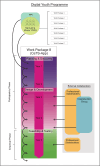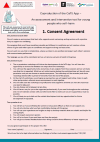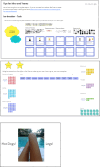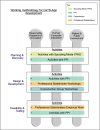Cultivating participatory processes in self-harm app development: A case-study and working methodology
- PMID: 39734924
- PMCID: PMC11669782
- DOI: 10.1002/jcv2.12295
Cultivating participatory processes in self-harm app development: A case-study and working methodology
Abstract
Background: Self-harm and suicide related behaviours are increasing in young people, and clinical support is not adequately meeting needs. Improved approaches to assessment and the clinical management of self-harm will result from codesign processes and include greater shared decision-making between young people and practitioners. The CaTS-App (an adapted digital version of the existing Card-Sort Task for Self-harm research tool) aims to facilitate a collaborative understanding of adolescent self-harm and support decision-making within clinical settings. The codevelopment of a digital, clinical tool which meets the needs of multiple stakeholders requires careful consideration.
Methods: We present a case-study describing the participatory aspects of the development of the CaTS-App, which included comprehensive patient involvement, research activities and coproduction with diverse young people aged 17-24 with lived experience of self-harm. We share our processes and activities to deliver safe, engaging, sustainable, ethical and responsible participatory practice and co-created knowledge, in the codevelopment of the CaTS-App.
Results: Activities spanned a 48-month period in both face-to-face and online settings. Example processes and activities are provided in narrative, tabular and diagrammatic form, alongside discussion of the rationale for choices made. A summary methodology is also shared to stimulate continued discussion and development of participatory approaches in digital mental health.
Conclusions: The paper contributes important insight and practical detail for the delivery of genuine participatory processes in digital mental health development when working with a population who may be considered vulnerable.
Keywords: PPI; card‐sort task for self‐harm; coproduction; digital interventions; self‐harm; young people.
© 2024 The Author(s). JCPP Advances published by John Wiley & Sons Ltd on behalf of Association for Child and Adolescent Mental Health.
Conflict of interest statement
None to declare.
Figures









References
-
- Arshad, U. , Farhat‐ul‐Ain, Gauntlett, J. , Husain, N. , Chaudhry, N. , & Taylor, P. J. (2020). A systematic review of the evidence supporting mobile‐ and internet‐based psychological interventions for self‐harm. Suicide and Life‐Threatening Behavior, 50(1), 151–179. 10.1111/sltb.12583 - DOI - PMC - PubMed
-
- Bevan Jones, R. , Thapar, A. A. K. , Rice, F. , Beeching, H. , Cichosz, R. , Mars, B. , Smith, D. , Merry, S. , Stallard, P. , Jones, I. , Thapar, A. A. K. , & Simpson, S. A. (2018). A web‐based psychoeducational intervention for adolescent depression: Design and development of MoodHwb. JMIR Mental Health, 5(1), e13. 10.2196/mental.8894 - DOI - PMC - PubMed
-
- Cliffe, B. , & Stallard, P. (2023). Evaluating a smartphone app for university students who self‐harm. Education Sciences, 13(4), 394. Article 4. 10.3390/educsci13040394 - DOI
-
- Čuš, A. , Edbrooke‐Childs, J. , Ohmann, S. , Plener, P. L. , & Akkaya‐Kalayci, T. (2021). “Smartphone apps are cool, but do they help me?”: A qualitative interview study of adolescents’ perspectives on using smartphone interventions to manage nonsuicidal self‐injury. International Journal of Environmental Research and Public Health, 18(6), 3289. 10.3390/ijerph18063289 - DOI - PMC - PubMed
LinkOut - more resources
Full Text Sources
Miscellaneous
